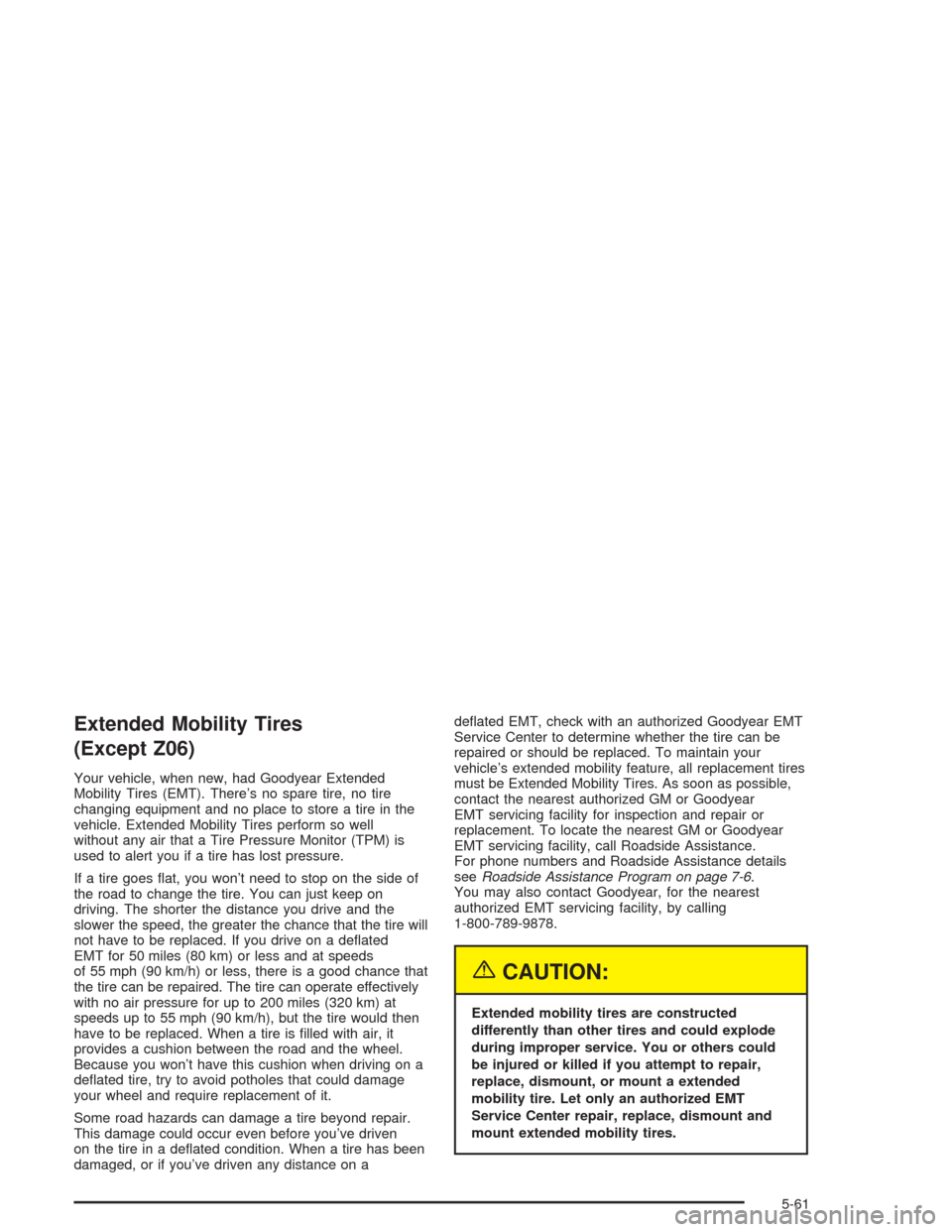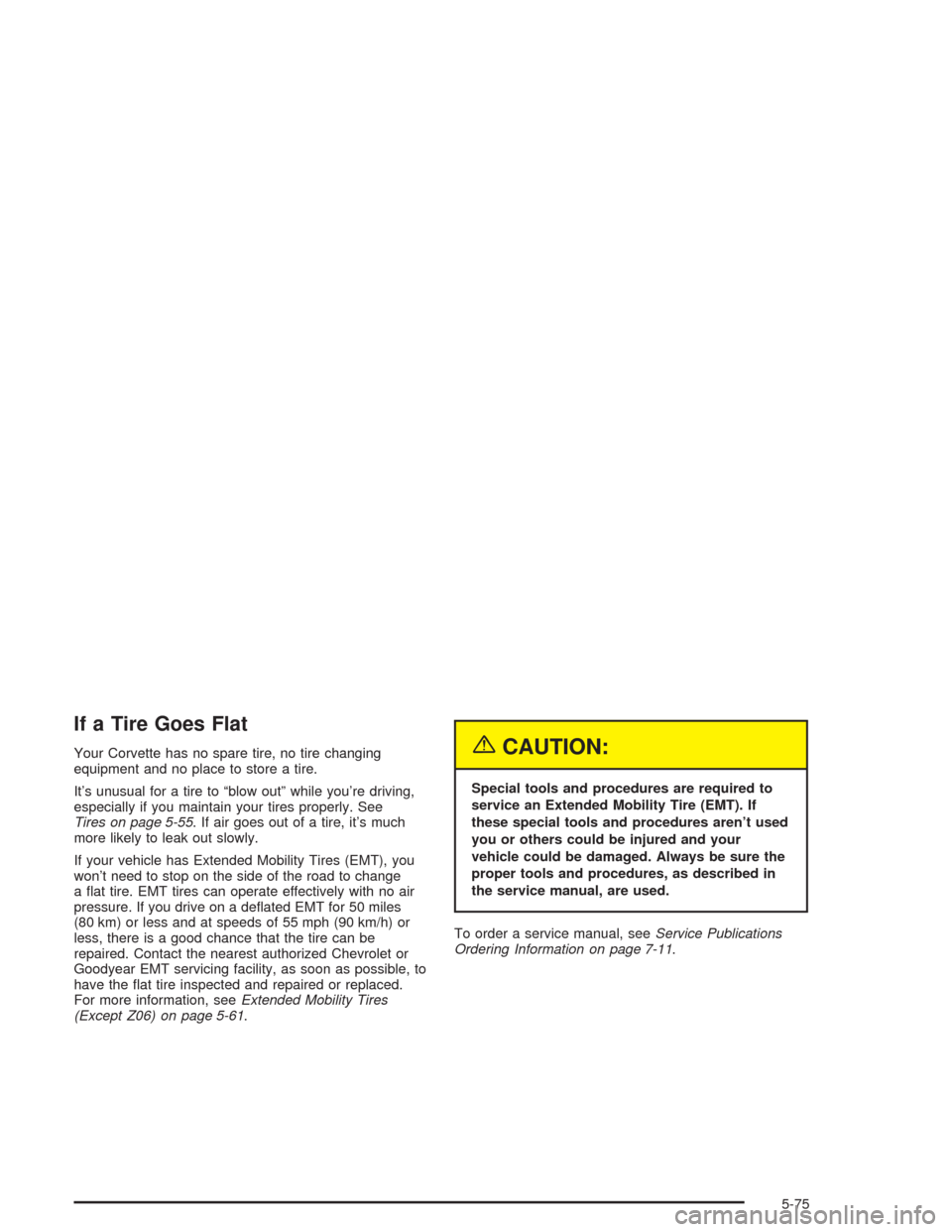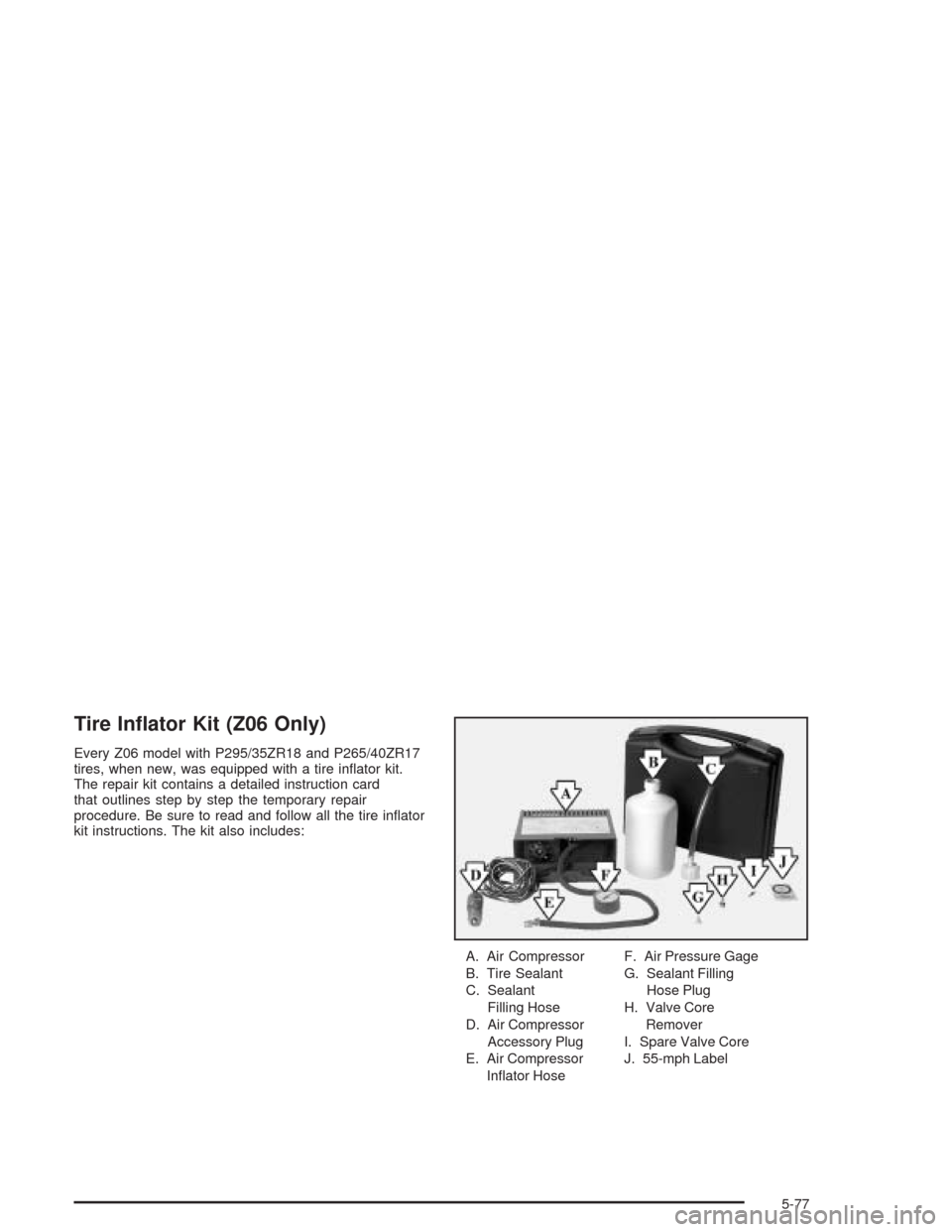2004 CHEVROLET CORVETTE spare tire
[x] Cancel search: spare tirePage 303 of 384

Extended Mobility Tires
(Except Z06)
Your vehicle, when new, had Goodyear Extended
Mobility Tires (EMT). There’s no spare tire, no tire
changing equipment and no place to store a tire in the
vehicle. Extended Mobility Tires perform so well
without any air that a Tire Pressure Monitor (TPM) is
used to alert you if a tire has lost pressure.
If a tire goes flat, you won’t need to stop on the side of
the road to change the tire. You can just keep on
driving. The shorter the distance you drive and the
slower the speed, the greater the chance that the tire will
not have to be replaced. If you drive on a deflated
EMT for 50 miles (80 km) or less and at speeds
of 55 mph (90 km/h) or less, there is a good chance that
the tire can be repaired. The tire can operate effectively
with no air pressure for up to 200 miles (320 km) at
speeds up to 55 mph (90 km/h), but the tire would then
have to be replaced. When a tire is filled with air, it
provides a cushion between the road and the wheel.
Because you won’t have this cushion when driving on a
deflated tire, try to avoid potholes that could damage
your wheel and require replacement of it.
Some road hazards can damage a tire beyond repair.
This damage could occur even before you’ve driven
on the tire in a deflated condition. When a tire has been
damaged, or if you’ve driven any distance on adeflated EMT, check with an authorized Goodyear EMT
Service Center to determine whether the tire can be
repaired or should be replaced. To maintain your
vehicle’s extended mobility feature, all replacement tires
must be Extended Mobility Tires. As soon as possible,
contact the nearest authorized GM or Goodyear
EMT servicing facility for inspection and repair or
replacement. To locate the nearest GM or Goodyear
EMT servicing facility, call Roadside Assistance.
For phone numbers and Roadside Assistance details
seeRoadside Assistance Program on page 7-6.
You may also contact Goodyear, for the nearest
authorized EMT servicing facility, by calling
1-800-789-9878.
{CAUTION:
Extended mobility tires are constructed
differently than other tires and could explode
during improper service. You or others could
be injured or killed if you attempt to repair,
replace, dismount, or mount a extended
mobility tire. Let only an authorized EMT
Service Center repair, replace, dismount and
mount extended mobility tires.
5-61
Page 309 of 384

Uniform Tire Quality Grading
Quality grades can be found where applicable on the
tire sidewall between tread shoulder and maximum
section width. For example:
Treadwear 200 Traction AA Temperature A
The following information relates to the system
developed by the United States National Highway
Traffic Safety Administration, which grades tires by
treadwear, traction and temperature performance. (This
applies only to vehicles sold in the United States.)
The grades are molded on the sidewalls of most
passenger car tires. The Uniform Tire Quality Grading
system does not apply to deep tread, winter-type
snow tires, space-saver or temporary use spare tires,
tires with nominal rim diameters of 10 to 12 inches
(25 to 30 cm), or to some limited-production tires.
While the tires available on General Motors passenger
cars and light trucks may vary with respect to these
grades, they must also conform to federal safety
requirements and additional General Motors Tire
Performance Criteria (TPC) standards.
Treadwear
The treadwear grade is a comparative rating based on
the wear rate of the tire when tested under controlled
conditions on a specified government test course.
For example, a tire graded 150 would wear one and
a half (1.5) times as well on the government course as
a tire graded 100. The relative performance of tires
depends upon the actual conditions of their use,
however, and may depart significantly from the norm
due to variations in driving habits, service practices and
differences in road characteristics and climate.
Traction – AA, A, B, C
The traction grades, from highest to lowest, are AA, A,
B, and C. Those grades represent the tire’s ability
to stop on wet pavement as measured under controlled
conditions on specified government test surfaces of
asphalt and concrete. A tire marked C may have poor
traction performance. Warning: The traction grade
assigned to this tire is based on straight-ahead braking
traction tests, and does not include acceleration,
cornering, hydroplaning, or peak traction characteristics.
5-67
Page 317 of 384

If a Tire Goes Flat
Your Corvette has no spare tire, no tire changing
equipment and no place to store a tire.
It’s unusual for a tire to “blow out” while you’re driving,
especially if you maintain your tires properly. See
Tires on page 5-55. If air goes out of a tire, it’s much
more likely to leak out slowly.
If your vehicle has Extended Mobility Tires (EMT), you
won’t need to stop on the side of the road to change
a flat tire. EMT tires can operate effectively with no air
pressure. If you drive on a deflated EMT for 50 miles
(80 km) or less and at speeds of 55 mph (90 km/h) or
less, there is a good chance that the tire can be
repaired. Contact the nearest authorized Chevrolet or
Goodyear EMT servicing facility, as soon as possible, to
have the flat tire inspected and repaired or replaced.
For more information, seeExtended Mobility Tires
(Except Z06) on page 5-61.{CAUTION:
Special tools and procedures are required to
service an Extended Mobility Tire (EMT). If
these special tools and procedures aren’t used
you or others could be injured and your
vehicle could be damaged. Always be sure the
proper tools and procedures, as described in
the service manual, are used.
To order a service manual, seeService Publications
Ordering Information on page 7-11.
5-75
Page 319 of 384

Tire In�ator Kit (Z06 Only)
Every Z06 model with P295/35ZR18 and P265/40ZR17
tires, when new, was equipped with a tire inflator kit.
The repair kit contains a detailed instruction card
that outlines step by step the temporary repair
procedure. Be sure to read and follow all the tire inflator
kit instructions. The kit also includes:
A. Air Compressor
B. Tire Sealant
C. Sealant
Filling Hose
D. Air Compressor
Accessory Plug
E. Air Compressor
Inflator HoseF. Air Pressure Gage
G. Sealant Filling
Hose Plug
H. Valve Core
Remover
I. Spare Valve Core
J. 55-mph Label
5-77
Page 364 of 384

Roadside Assistance Program
Security While You Travel
1-800-CHEV-USA (243-8872)
As the proud owner of a new Chevrolet vehicle, you are
automatically enrolled in the Chevrolet Roadside
Assistance program. This value-added service is
intended to provide you with peace of mind as you drive
in the city or travel the open road. Chevrolet’s Roadside
Assistance toll-free number is staffed by courteous
and capable Roadside Assistance Representatives who
are available 24 hours a day, 365 days a year.
We will provide the following services during the
Bumper-to-Bumper warranty period, at no expense
to you:
•Fuel Delivery:Delivery of enough fuel
($5 maximum) for the customer to get to the
nearest service station.
•Lock-out Service (identi�cation required):
Replacement keys or locksmith service will
be covered at no charge if you are unable to gain
entry into your vehicle. Delivery of the replacement
key will be covered within 10 miles.
•Emergency Tow:Tow to the nearest dealership for
warranty service or in the event of a
vehicle-disabling accident. Assistance when the
vehicle is mired in sand, mud or snow.
•Flat Tire Change:Installation of a spare tire will be
covered at no charge. (The customer is responsible
for the repair or replacement of the tire if not
covered by a warrantable failure.)
•Jump Start:No-start occurrences which require a
battery jump start will be covered at no charge.
•Dealer Locator Service
In many instances, mechanical failures are covered
under Chevrolet’s Bumper-to-Bumper warranty.
However, when other services are utilized, our Roadside
Assistance Representatives will explain any payment
obligations you might incur.
For prompt and efficient assistance when calling, please
provide the following to the Roadside Assistance
Representative:
•Your name, home address, and home telephone
number
•Telephone number of your location
•Location of the vehicle
•Model, year, color, and license plate number
•Mileage, Vehicle Identification Number and delivery
date of the vehicle
•Description of the problem
7-6